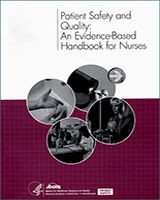Table 1
Taxonomy of Quality Improvement Strategies With Examples of Substrategies
| QI Strategy | Examples |
|---|---|
| Provider reminder systems |
|
| Facilitated relay of clinical data to providers |
|
| Audit and feedback |
|
| Provider education |
|
| Patient education |
|
| Patient reminder systems |
|
| Promotion of self-management |
|
| Organizational change |
|
| Financial incentives, regulation, and policy | Provider directed:
|
Note: Reprinted with permission from AHRQ38 (pp. 17–18).
- PubMedLinks to PubMed
- Six Sigma: not for the faint of heart.[Radiol Manage. 2003]Six Sigma: not for the faint of heart.Benedetto AR. Radiol Manage. 2003 Mar-Apr; 25(2):40-53.
- Keeping the "continuous" in continuous quality improvement: exploring perceived outcomes of CQI program use in community pharmacy.[Res Social Adm Pharm. 2014]Keeping the "continuous" in continuous quality improvement: exploring perceived outcomes of CQI program use in community pharmacy.Boyle TA, Bishop AC, Duggan K, Reid C, Mahaffey T, MacKinnon NJ, Mahaffey A. Res Social Adm Pharm. 2014 Jan-Feb; 10(1):45-57. Epub 2013 Mar 23.
- Understanding uptake of continuous quality improvement in Indigenous primary health care: lessons from a multi-site case study of the Audit and Best Practice for Chronic Disease project.[Implement Sci. 2010]Understanding uptake of continuous quality improvement in Indigenous primary health care: lessons from a multi-site case study of the Audit and Best Practice for Chronic Disease project.Gardner KL, Dowden M, Togni S, Bailie R. Implement Sci. 2010 Mar 13; 5:21. Epub 2010 Mar 13.
- Review Leadership, safety climate, and continuous quality improvement: impact on process quality and patient safety.[J Nurs Adm. 2014]Review Leadership, safety climate, and continuous quality improvement: impact on process quality and patient safety.McFadden KL, Stock GN, Gowen CR 3rd. J Nurs Adm. 2014 Oct; 44(10 Suppl):S27-37.
- Review The continuous quality improvement process in dynamic and rapid change.[Semin Nurse Manag. 1996]Review The continuous quality improvement process in dynamic and rapid change.Mount CB. Semin Nurse Manag. 1996 Mar; 4(1):55-9.
- Table 1, [Taxonomy of Quality Improvement Strategies With Examples of Substrateg...Table 1, [Taxonomy of Quality Improvement Strategies With Examples of Substrategies]. - Patient Safety and Quality
- Ophidiomyces ophidiicola strain NWHC 24395-1, whole genome shotgun sequencing pr...Ophidiomyces ophidiicola strain NWHC 24395-1, whole genome shotgun sequencing projectgi|2219277790|gb|JALBBV000000000.1| V010000000Nucleotide
- Pathogen: clinical or host-associated sample from Ophidiomyces ophidiicolaPathogen: clinical or host-associated sample from Ophidiomyces ophidiicolabiosample
- Ophidiomyces ophidiicola strain NWHC 22687-1 mitochondrion, complete sequence, w...Ophidiomyces ophidiicola strain NWHC 22687-1 mitochondrion, complete sequence, whole genome shotgun sequencegi|2219904357|gb|CM040740.1||gnl|WG BCK|mtNucleotide
Your browsing activity is empty.
Activity recording is turned off.
See more...
